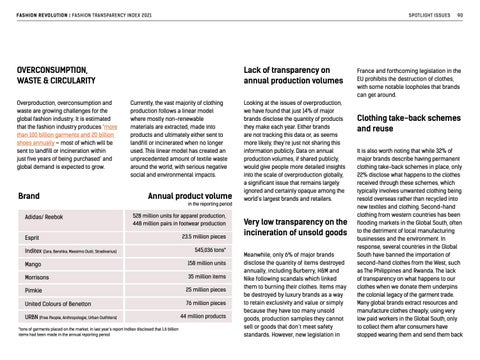FASHION REVOLUTION | FASHION TRANSPARENCY INDEX 2021
SPOTLIGHT ISSUES
OVERCONSUMPTION, WASTE & CIRCULARITY Overproduction, overconsumption and waste are growing challenges for the global fashion industry. It is estimated that the fashion industry produces ‘more than 100 billion garments and 20 billion shoes annually – most of which will be sent to landfill or incineration within just five years of being purchased’ and global demand is expected to grow.
Brand
Lack of transparency on annual production volumes Currently, the vast majority of clothing production follows a linear model where mostly non-renewable materials are extracted, made into products and ultimately either sent to landfill or incinerated when no longer used. This linear model has created an unprecedented amount of textile waste around the world, with serious negative social and environmental impacts.
Annual product volume in the reporting period
Adidas/ Reebok
528 million units for apparel production, 448 million pairs in footwear production
Esprit Inditex (Zara, Bershka, Massimo Dutti, Stradivarius)
23.5 million pieces 545,036 tons*
Mango
158 million units
Morrisons
35 million items
Pimkie
25 million pieces
United Colours of Benetton
76 million pieces
URBN (Free People, Anthropologie, Urban Outfitters) *tons of garments placed on the market; in last year’s report Inditex disclosed that 1.6 billion items had been made in the annual reporting period
44 million products
Looking at the issues of overproduction, we have found that just 14% of major brands disclose the quantity of products they make each year. Either brands are not tracking this data or, as seems more likely, they’re just not sharing this information publicly. Data on annual production volumes, if shared publicly, would give people more detailed insights into the scale of overproduction globally, a significant issue that remains largely ignored and certainly opaque among the world’s largest brands and retailers.
Very low transparency on the incineration of unsold goods Meanwhile, only 6% of major brands disclose the quantity of items destroyed annually, including Burberry, H&M and Nike following scandals which linked them to burning their clothes. Items may be destroyed by luxury brands as a way to retain exclusivity and value or simply because they have too many unsold goods, production samples they cannot sell or goods that don’t meet safety standards. However, new legislation in
90
France and forthcoming legislation in the EU prohibits the destruction of clothes, with some notable loopholes that brands can get around.
Clothing take-back schemes and reuse It is also worth noting that while 32% of major brands describe having permanent clothing take-back schemes in place, only 22% disclose what happens to the clothes received through these schemes, which typically involves unwanted clothing being resold overseas rather than recycled into new textiles and clothing. Second-hand clothing from western countries has been flooding markets in the Global South, often to the detriment of local manufacturing businesses and the environment. In response, several countries in the Global South have banned the importation of second-hand clothes from the West, such as The Philippines and Rwanda. The lack of transparency on what happens to our clothes when we donate them underpins the colonial legacy of the garment trade. Many global brands extract resources and manufacture clothes cheaply, using very low paid workers in the Global South, only to collect them after consumers have stopped wearing them and send them back
